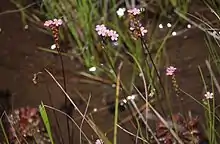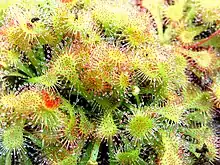| Drosera tokaiensis | |
|---|---|
 | |
| Scientific classification | |
| Kingdom: | Plantae |
| Clade: | Tracheophytes |
| Clade: | Angiosperms |
| Clade: | Eudicots |
| Order: | Caryophyllales |
| Family: | Droseraceae |
| Genus: | Drosera |
| Subgenus: | Drosera subg. Drosera |
| Section: | Drosera sect. Drosera |
| Species: | D. tokaiensis |
| Binomial name | |
| Drosera tokaiensis (Komiya & Shibata) T.Nakamura & Ueda (1991) | |
| Synonyms | |
| |
Drosera tokaiensis is a species of sundew native to Japan. It is considered to be a natural hybrid of Drosera rotundifolia and Drosera spatulata. These two parent species have 20 and 40 chromosomes, respectively, so recent hybrids between them are sterile, having 30 chromosomes, while the stabilized, fertile D. tokaiensis has 60 (i.e. allohexaploid).[1] The species was previously thought to be a subspecies or variety of Drosera spatulata. It is often mistaken for D. spatulata in cultivation.

Drosera tokaiensis in cultivation
.jpg.webp) flower
flower.jpg.webp) leaf
leaf
References
Wikimedia Commons has media related to Drosera tokaiensis.
- ↑ Brittnacher, John, Growing the Drosera spatulata species complex, International Carnivorous Plant Society (ICPS), retrieved 2017-06-23
This article is issued from Wikipedia. The text is licensed under Creative Commons - Attribution - Sharealike. Additional terms may apply for the media files.